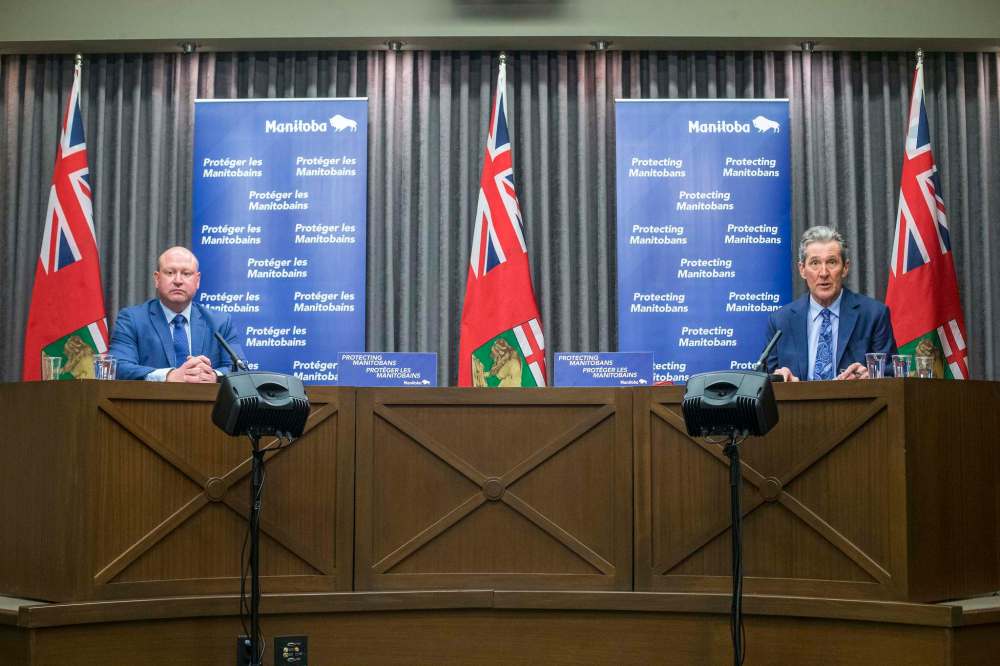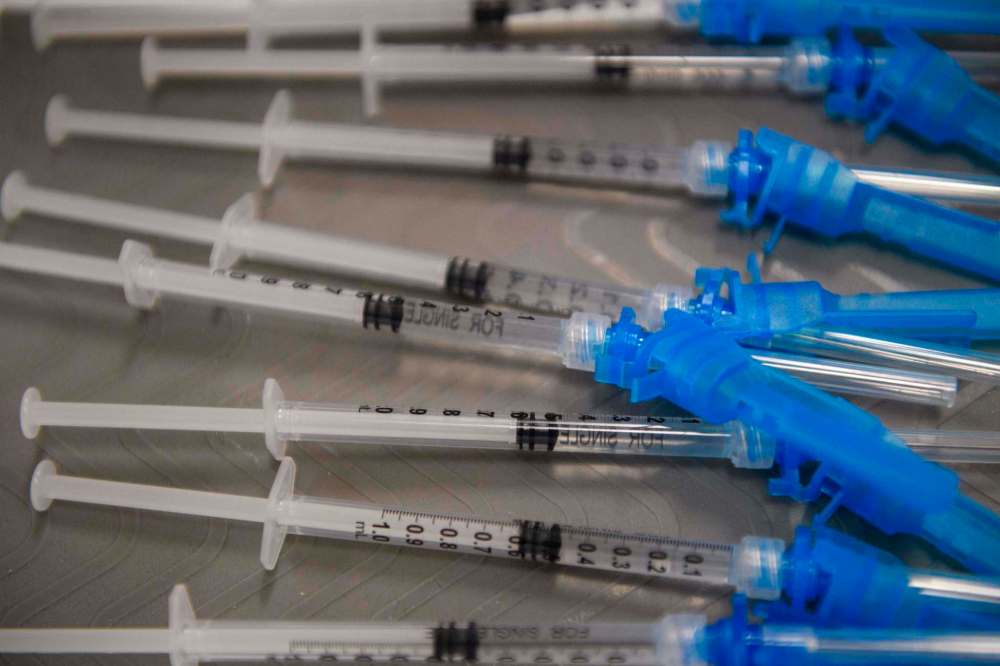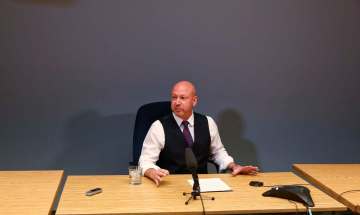Threading the needle Health officials face tough challenge in crafting messaging to encourage vaccinations: everything changes, but nothing changes
Read this article for free:
or
Already have an account? Log in here »
To continue reading, please subscribe:
Monthly Digital Subscription
$0 for the first 4 weeks*
- Enjoy unlimited reading on winnipegfreepress.com
- Read the E-Edition, our digital replica newspaper
- Access News Break, our award-winning app
- Play interactive puzzles
*No charge for 4 weeks then price increases to the regular rate of $19.00 plus GST every four weeks. Offer available to new and qualified returning subscribers only. Cancel any time.
Monthly Digital Subscription
$4.75/week*
- Enjoy unlimited reading on winnipegfreepress.com
- Read the E-Edition, our digital replica newspaper
- Access News Break, our award-winning app
- Play interactive puzzles
*Billed as $19 plus GST every four weeks. Cancel any time.
To continue reading, please subscribe:
Add Free Press access to your Brandon Sun subscription for only an additional
$1 for the first 4 weeks*
*Your next subscription payment will increase by $1.00 and you will be charged $16.99 plus GST for four weeks. After four weeks, your payment will increase to $23.99 plus GST every four weeks.
Read unlimited articles for free today:
or
Already have an account? Log in here »
Hey there, time traveller!
This article was published 12/03/2021 (1732 days ago), so information in it may no longer be current.
If you ask a federal or Manitoba official what happens when you get vaccinated against COVID-19, the response is not the most uplifting.
You still have to wear a mask, says Dr. Theresa Tam.
You need to avoid indoor gatherings, Dr. Brent Roussin reminds us.
Premier Brian Pallister says the hockey game isn’t over, and we’re playing defence.

As of Friday, just 5.6 per cent of adults in Canada had received their first injection. The vaccines prevent serious illness, but experts still aren’t sure how well each shot prevents people from spreading the coronavirus.
Still, European governments have focused for months on the prospect of travel, family gatherings and going back to school. They’re trying to convince citizens to roll up their sleeves by using clear examples instead of focusing only on the unknowns.
Canada might soon strike the same tune, with a massive ramp-up in vaccine shipments, and this week’s news that vaccinated Americans can safely have visitors.
But we’re still some distance from widespread immunization, leaving public-health officials trying to hit a delicate balance between keeping the public optimistic without letting new variants create a massive third wave.
“This is an incredibly challenging phase, because there are vaccines that will be coming on the horizon, but the reality is that a very small amount of the Canadian population has been vaccinated,” says Heidi Tworek, a University of British Columbia public-policy professor.
“So we’re trying to manage, in our communication, the time horizon of two kind of quite diametrically opposed emotions, simultaneously.”
Avoiding a nightmare
This week, the military deployed to the remote Pukatawagan reserve in northwest Manitoba, after a few dozen Moderna doses caused many in the First Nation of 3,000 to let down their guard.
In less just a week, the fly-in community, also called Mathias Colomb, went from a COVID-19 case count of 10 to 101.
“When we first got our needles, that’s when everything went out of control,” says Chief Lorna Bighetty.
“They just went out and about, visiting each other, having their parties, just like nothing was wrong.”
“When we first got our needles, that’s when everything went out of control.” – Pukatawagan Chief Lorna Bighetty.
That’s the nightmare health officials are trying to avoid when they craft messaging for the public.
It’s clear all the main vaccines prevent illness, but it’s unknown how well they cut down on spread, and how likely a vaccinated person with no symptoms could infect others.
“We don’t have enough data yet, and the consequence of making a mistake and saying everyone can go and get vaccinated and live their lives the way they want immediately, could be quite horrifying,” says Dr. Tara Moriarty, a University of Toronto infectious-diseases professor.
The extent of protection could depend on age group and timing of the doses, and that could also affect whether people can still transmit the coronavirus, particularly as variants rise.
‘Winnable moments’
On Monday, the Centers for Disease Control and Prevention gave Americans the first concrete example of the benefit of getting vaccinated that isn’t about hospital visits.
People who are two weeks past their final COVID-19 shot can visit unvaccinated people indoors without masks or distancing.
Dr. Michael Osterholm, a prominent Minnesota epidemiologist, says these types of rules are important for keeping up public morale, and thus compliance with public-health measures.

He argues the public needs to be able to imagine safe gatherings they will eventually partake in, which he dubs “winnable moments,” such as having someone over for dinner or kids hugging grandma.
“We need more direction that way with vaccines,” he said in a recent podcast.
“I’ve had more people to say to me, ‘Why in the hell did I get this vaccine if it means I have to do everything the same way I’ve been doing it before?’ And you know what, that’s a perfectly legitimate question,” he said, arguing now is the time to plan for these moments.
“We need to define them, and we need to say under what conditions they need to occur.”
Yet in the United States, more than 10 per cent of adults are fully vaccinated, compared with just 5.11 per cent in Canada.
“The reality of the situation on the ground in Canada is that most of the population is still very vulnerable to COVID,” says Tworek, who has compared different countries’ communications approaches since the start of the pandemic.
However, “if one gets a vaccine and nothing changes, how do you think about incentive structures?”
The European approach
In France, a government commercial released this month shows an older woman hugging her grandchildren, before realizing she’s daydreaming while sitting in a vaccination clinic, having just got the jab.
The nurses asks if the shot hurt. “Not at all; au contraire,” the woman says with a smile.
https://www.youtube.com/watch?v=IVMLQbjYEKc
Back in January, when hardly any doses were available, the European Commission started a social media campaign that focused on the ability to travel, return to work and see friends.
Those approaches likely reflect Europeans having more hesitancy toward pharmaceutical companies and new vaccines.
But it also aims to communicate that life will eventually return to normal — even if there are still serious risks.
Ireland shows the risk of letting down one’s guard.
The country had some of the lowest COVID-19 levels in Europe leading into Christmas, when people gathered and the highly contagious B.1.1.7 variant gained traction.

Cases multiplied sixfold in less than a month, leading to a three-month lockdown that prohibits travelling five kilometres from home — even as the pace of vaccination picks up.
“We know you can have a weird situation where you’re locked down and vaccines are progressing,” Tworek says.
“A vaccine will be miraculously effective, but if people stop adhering to guidelines now, you could end up with a massive hike in cases.”
That means focusing Canadians on a future that is just beyond the horizon.
This week, the British Columbia government announced its universities should prepare for classes to resume in person in the fall.
“Part of the strategy is to give people a perspective moving forward that isn’t necessarily about the individual, like saying people with vaccine will be able to do something that unvaccinated people cannot,” Tworek says.

“It’s trying to give people the perspective that better times are around the horizon, but we need to still hunker down for now.”
The Manitoba government said Friday it is working on a communications strategy with different segments of the population.
Officials believe more than 60 per cent of Manitoba residents are keen to get the vaccine, while about 30 per cent “are likely to get vaccinated but will need additional encouragement and information about the urgency and importance of vaccination,” a spokeswoman wrote.
“We have been working with community organizations, Indigenous communities and other stakeholders to develop targeted and province-wide strategies around vaccination.”
A cautious tone
Dr. Jason Kindrachuk, a University of Manitoba virologist, says hinting at future benefits of vaccination is inherently hard for scientists who don’t fully know what will be possible.
“We are, as scientists, trained classically to always err on the side of caution with our results, and not over-interpret what we see. That’s part of our trade,” he says.
Already, critics have blasted health officials for dithering at the start of the pandemic about whether to wear masks in public. Experts say the research wasn’t clear at that point on whether masks would prevent COVID-19 transmission or instead result in people not keeping a safe distance in order to more clearly communicate with others.
Kindrachuk says experts are terrified of giving the wrong information about vaccines when a vocal portion of society is already hesitant about immunizations.
“We certainly do not want, as a community, to be providing any sort of false notions to the public that might not be substantiated.”
For example, suggesting vaccines prevent transmission without knowing the full story could cause people to make unsafe choices. “Then you have concerns about what happens now in regards to people’s trust in science.”
Hope on the horizon
Tworek points out that public-health officials adjust their messaging to account for both how people personally feel, and their capacity for altruism.
“Any risk-communication tries to take in both factors, the pro-self and the pro-social, and you might change the weighting at different moments,” she says.
For example, officials can point out that wearing a mask protects others, or focus on how it keeps case counts low and prevents your gym from closing due to harsher lockdowns.
Canadians have consistently reported being more concerned about their relatives getting sick from COVID-19 than themselves.
And the rate of personal concern about contracting the coronavirus generally patterns the severity of spread in the community. This week, the Angus-Reid Institute found 62 per cent of Canadians were concerned about getting infected, down from 71 per cent in January, but up from 46 per cent last June.
That suggests less personal concern if cases continue to drop, though variants could trigger a dangerous third wave.
Tworek said those trends might shape how officials communicate the benefits of vaccinations, as well as the unknowns, particularly if the majority of one age group has been vaccinated while others have not.
“It depends what demographics you’re trying to reach, and that’s been true throughout COVID,” she says.
“People just need to hang on for another month or two, even if they’re vaccinated– still keep doing all the protective measures they adopt, and just hang on until we have more data.” – Dr. Tara Moriarty, University of Toronto infectious-diseases professor.
Moriarty says Manitobans have so much to look forward to, especially as evidence pours in on how vaccines have impacted COVID-19 transmission among personal-care home residents, who are most vulnerable to the coronavirus.
She predicts staff will no longer have to wear gowns and face shields, which have alarmed some people with dementia. Shortly after that, relatives might be able to visit.
The massive ramp-up in vaccine shipments suggests Manitobans will be able to gather at some point this year without masks, especially if this week’s CDC policy on gatherings doesn’t lead to a jump in American cases.
“People just need to hang on for another month or two, even if they’re vaccinated — still keep doing all the protective measures they adopt, and just hang on until we have more data,” Moriarty says.
“Once we do, public-health authorities and others will be the first who will want to lift those restrictions, because it’s also so challenging convincing people to continue with them.”
dylan.robertson@freepress.mb.ca
History
Updated on Saturday, March 13, 2021 4:42 PM CST: Corrects typos, updates percentage of Canadians vaccinated.








